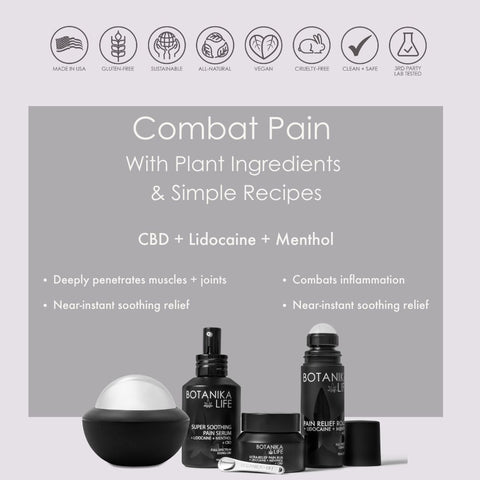
How to Remedy Post-Hike Leg Pain + Sore Calf Muscles
Surprise, surprise, trekking through rugged terrain and challenging trails puts a significant strain on your legs and calves. Although most sore muscle aches and pains clear up within a couple of days, this discomfort can disturb your normal routine and inhibit additional physical activities you want to engage in right after a big hike. Like, let’s say, another hike!
Smart trekkers take precautions to both limit such strains, as well as prepare post-hike remedies for leg and calf pain. Solutions can be both behavioral-based (like stretching) or having specific pain-relief products ready for when they’ll be most effective.
Why Sore Calf Muscles and Leg Pain Can Occur
Your calves are an integral part of helping you push off while walking and can take a beating when it comes to hiking. Sore legs after hiking and the well-known hiker's calf pain are normal post-hike results, and here's why.
With each step, your calves flex to help push your toes off the ground. This movement is even more demanding when you're walking against gravity. Add a heavy backpack and varied terrain to this equation, and painful legs and calves are standard after strenuous or extended hikes. There are a variety of potential contributors to this pain, including the following:
- Straining muscles in new ways
- Poorly fitted or subpar footwear
- Heat exhaustion
- Delayed Onset Muscle Soreness (DOMS)
- Overload from strain
- Inadequate strength
- Muscle cramps
- Dehydration or lack of proper nutrition
- Weakness from past injuries
How to Prevent & Minimize Leg and Calf Pain For Hiking
Stretching
One of the best ways to remedy sore legs and calf pain is to prepare your muscles beforehand and follow up with stretching immediately afterward.
Whether taking long walks or hiking a steep mountain, your muscles will invariably get tighter because they are continuously working in the same repetitive motion. Over long periods of extended use, muscles, tendons, and fascia become stronger, tighter, and shorter.
Stretching before your hike helps loosen and prepare your muscles for the physical challenge to come. Remember that a post-workout stretch can aid your recovery after a strenuous hike or long walk when your leg or calf pain might inhibit normal activities. Stretching helps to rebalance tightness, often relieving calf pain after hiking and assisting in injury prevention.
Exercises like leg swings, knee lifts, and walking lunges are beneficial stretches for leg pain after walking too much. Following your trek, focus on stretching your hamstrings, quadriceps, calves, and hip flexors, holding each stretch for at least 15-30 seconds to promote relaxation and reduce the risk of post-hike soreness.
Click here for a great video demonstrating proper stretching to lessen leg and calf pain after too much walking.
Proper hydration
Staying hydrated is another essential way to reduce sore calves after hiking because dehydration can exacerbate muscle cramping and post-hike soreness. Drinking enough water or other hydrating liquids helps your muscles contract and relax smoothly, preventing irritation of muscle fibers and cells.
In addition to staying hydrated with fresh water, adding electrolyte-rich beverages to the mix is a great way to combat heat exhaustion and keep your muscles working to the best of their ability. Electrolytes help restore vital minerals lost through sweating, lowering the risk of muscle cramps, fatigue, and post-hike soreness of your calves and legs.
To ensure your muscles receive the nutrients and oxygen they need during your walk or hike, plan ahead with adequate water and consistently fuel yourself with liquids during your journey. Be mindful that keeping your fluid intake high while your body is in recovery mode is also helpful in combating day-after muscle soreness.
Ensuring you have supportive footwear
Choosing proper footwear is crucial for preventing sore muscles after hiking. The wrong hiking shoes can increase the risk of muscle fatigue, soreness, pain, and even injuries.
Investing in good quality hiking shoes or boots is not just about comfort—it's a key factor in maintaining your muscle, tendon, and joint health while on the trail. Walking shoes and hiking boots must provide adequate ankle support to help you maneuver uneven trails. Boots that don’t fit well can also cause joint or ligament pain, making it essential to choose hiking boots that fully support your feet. Also, shoes with proper arch support and a snug but not overly tight overall fit are critical in avoiding blisters.
Start by visiting a specialty footwear or outdoor store and work with an experienced salesperson to ensure a proper fit. If pain persists, consult a podiatrist about the calf and leg aches you experience after long walks. They may be able to recommend custom insoles that help lessen the strain.
Bring hiking poles
A trekking pole, also known as a hiking pole, is similar in appearance to a ski pole and is used for stability when hiking. Trekking poles come in pairs and are especially helpful when climbing a steep incline or decline and when the terrain is slippery or rocky.
Hiking poles can provide anchor points, helping to distribute the pressure on your body and lessening strain on your calves and legs. Using poles while hiking can improve your balance, decrease muscle fatigue, and greatly lower the risk of leg pain after your hike. When purchasing hiking poles, consider ones with shock-absorbing features to help reduce the impact on your muscles and joints.
Consider compression socks
Adding compression socks to your hiking gear can help avoid post-hike issues like leg pain after walking too much. Hiking compression socks offer the same benefits as medical compression socks, improving circulation and increasing stability. The gradual compression from the ankle to the calf provided by compression socks helps to improve circulation throughout your feet and legs while hiking, helping transport oxygen and nutrients to your muscles more quickly.
Compression socks also offer added stability for muscles and joints while walking and hiking, making it easier to manage uneven or slippery terrain. They also help reduce the risk of muscle cramps, injuries, and notorious blisters from long hours on your feet.
Proper training before hiking
Preparing your body for a demanding hike is not an overnight task. A comprehensive training plan starting with gradual conditioning will help alleviate post-hike pain in your calves and legs.
Start slowly by boosting your endurance through regular cardiovascular exercises like jogging, cycling, or brisk walking to build stamina. Planning for gradual increases in hike distances and terrain difficulty, adding easier hikes in between for a bit of rest, is the ideal way to prep your body while not pushing it too far and fast.
Strength training exercises for your legs, core, and upper body will enhance your ability to handle long hikes. Strengthening your leg muscles not only increases stamina for more difficult trails but also reduces the risk of injuries in weaker muscle groups, not to mention helps with calf and leg soreness.
Remember, the size and weight of your backpack can make a big difference when hiking. As you train, consider the weight of your pack and balance it with the distance and difficulty of your hikes.
Be strategic with the foods you consume
A well-balanced diet is essential to success with any type of exercise, including hiking. Not only does a diet consisting of carbohydrates, protein, and important vitamins and minerals help you maintain energy levels during a hike, but it also plays a role in muscle recovery, including decreasing aches and pains.
Carbohydrates, such as whole grain pasta, rice, vegetables, and fruits, fuel your muscles during long hikes. But even more importantly, protein is necessary to maintain muscle strength and repair after exercise. Foods like lean protein, eggs, cheese, and nuts are great options before, during, and after your walk or hike.
Invest in a backpack designed to distribute weight evenly
Finding the right backpacking gear can make or break your post-hike leg soreness. The weight you carry on your back significantly impacts your health during a trek, so opting for lightweight backpacking gear can dramatically decrease the strain on your legs and calves.
Good quality hiking backpacks can be offered with adjustable straps and padded hip belts, distributing the weight of your pack evenly across your body. Along with these qualities of a backpack, choosing one that is lightweight will also ensure less pressure on your lower body as you hike.
How to Address Sore Calves During Your Hike or After
Topical pain products

When you need targeted and deep pain relief in an instant, Botanika Life topical pain relief products have you covered. Infused with full-spectrum CBD, menthol, lidocaine, and other natural ingredients, we balanced these products to provide both near-instant relief and anti-inflammatory properties that help minimize soreness in the long term. To use these products to maximum effect, consider:
Massage your calves
Massaging your calves and legs can speed up muscle recovery and get you back on the trail more quickly. Ideally, use a cryo massage tool—a stainless-steel cryo ball that has been frozen or refrigerated. This helps to reduce inflammation and lactic acid buildup, promoting faster healing.
Cryo massage rollers are also a perfect partner with CBD massage cream, working together to increase each other’s benefits. When massaging your legs or calves, apply firm pressure and glide the massage ball up and down along the calf, starting above your ankle. Focus on both sides of your lower leg, especially the more muscular part of your calf. Ensure the pressure remains comfortable and never painful, and spend 3 to 5 minutes massaging this area.
R.I.C.E.
When dealing with sore legs and calves after a hike, the R.I.C.E. method (Rest, Ice, Compression, and Elevation) is a tried-and-true approach to promote healing and provide relief during the first 48 to 72 hours after intense physical activity.
The R.I.C.E. procedure is simple and easy. It includes resting the injured or sore area, using an ice pack or other cryotherapy method for around 20 minutes, wrapping the area for compression, and elevating above the level of your heart. This method can be repeated every 2 to 3 hours throughout the day. Incorporate a cryo massage roller into the mix for additional recovery, adding to your relief.
Sleep
If you are looking for ways to relieve sore muscles after hiking, making time for recovery is a necessary step. Recovery can include days of complete rest, shorter hikes, fueling your body with good food and hydration, and, last but not least, sleep.
During deep sleep, your body replenishes energy and heals micro tears in the muscles, aka pulled muscles, which can cause soreness and pain. Don't take your post-hike sleep for granted; it is the easiest way to heal your body and prepare for your next adventure.

Include Active Recovery
Active recovery is beneficial after long treks because it helps increase blood flow to sore muscles, promoting recovery and reducing soreness. A thorough warm-up before exercise prepares your muscles and reduces the risk of soreness after extensive walking or hiking. In addition to stretching after your trek, engaging in activities like walking, cycling, or swimming aids in flushing out toxins and delivering oxygen and nutrients to your muscles, speeding up the healing process.

By Emily Wegener
With a unique background as an Integrative Nutrition Health Coach, Masters Degree in Teaching and experience in Psychology, Emily spends much of her time researching and trying out new holistic healing modalities.


